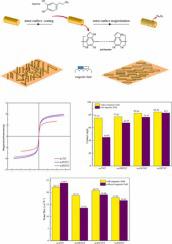Process Safety and Environmental Protection ( IF 6.9 ) Pub Date : 2022-08-03 , DOI: 10.1016/j.psep.2022.07.066 Z. Fallahnejad , Gh. Bakeri , A.F. Ismail

|
Today, one of the most imortant environmental problems is the treatment of industrial wastewaters containing heavy metal ions and salts. In this research, thin-film nanocomposite (TFN) membranes were developed through incorporation of modified titanate nanotube (TNT) and halloysite nanotube (HNT) into the polyamide (PA) active layer to improve the performance of the NF membranes. At first, the internal surface of the nanotubes was coated with different polymers to lessen the inner diameter of the nanotubes. Then, the inner surface coated nanotubes were magnetized through placing Fe3O4 on their outer surface. In case of magnetized nanotubes, the fabrication of the membranes was done in the absence and in the presence of the external magnetic field, which made the nanotubes to align in a regular pattern across the PA layer, smoothing the membranes' surface and lowering the contact angle. It is expected that the magnetized nanotubes can make suitable arrangement in the structure of thin layer in the presence of the magnetic field and show better performance. The nanotubes act as the channels for water transport and in case of inner coated nanotubes, reject more ions through the steric hindrance. The pure water permeation of the membranes, modified with polystyrene inner coated TNT and HNT increased by 71.23% and 80.27%, respectively compared to the pristine TFC membrane without any significant changes in the rejection of Na+ and Cu2+; a suitable trade-off between the permeation and the ion rejection. In addition, the membranes modified by magnetized polyaniline inner coated TNT and HNT showed 36.24% and 75.62% more water permeation compared to the pristine TFC membranes while the rejections of Na+ and Cu2+ have not been changed remarkably. The results of this research showed that inner coating and magnetization of the nanotubes can be considered as a novel method to enhance the efficiency of TFN membranes for wastewaters treatment.
中文翻译:

通过嵌入磁性内表面功能化纳米管克服TFN纳滤膜渗透和排斥之间的权衡
今天,最重要的环境问题之一是处理含有重金属离子和盐的工业废水。在这项研究中,通过将改性钛酸盐纳米管 (TNT) 和埃洛石纳米管(HNT) 掺入到聚酰胺(PA) 活性层中来开发薄膜纳米复合材料 (TFN) 膜,以提高 NF 膜的性能。首先,纳米管的内表面涂有不同的聚合物以减小纳米管的内径。然后,通过放置Fe 3 O 4对内表面包覆的纳米管进行磁化。在它们的外表面上。在磁化纳米管的情况下,膜的制造是在没有和存在外部磁场的情况下完成的,这使得纳米管在 PA 层上以规则的图案排列,使膜的表面光滑并降低接触角度。预计磁化后的纳米管在磁场存在的情况下可以在薄层结构中进行合适的排列,并表现出更好的性能。纳米管充当水传输的通道,并且在内部涂覆的纳米管的情况下,通过空间位阻拒绝更多的离子。纯水渗透膜,聚苯乙烯改性与原始 TFC 膜相比,内涂层 TNT 和 HNT 分别增加了 71.23% 和 80.27%,而对 Na +和 Cu2+的截留率没有任何显着变化;渗透和离子排斥之间的适当折衷。此外,磁化聚苯胺内包覆TNT和HNT改性的膜与原始TFC膜相比,透水率提高了36.24%和75.62%,而Na+和Cu2+没有显着变化。这项研究的结果表明,纳米管的内涂层和磁化可以被认为是一种提高 TFN 膜用于废水处理的效率的新方法。











































 京公网安备 11010802027423号
京公网安备 11010802027423号